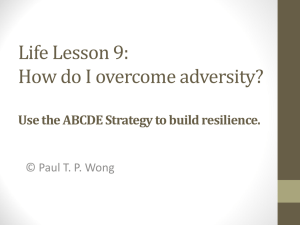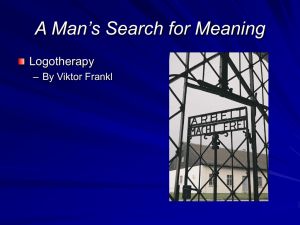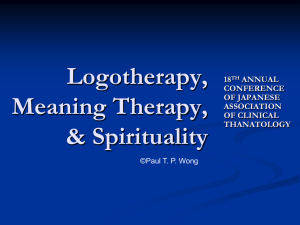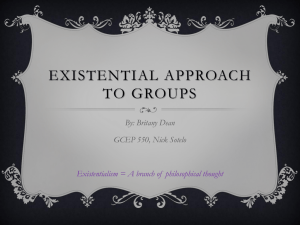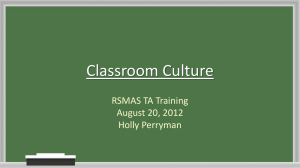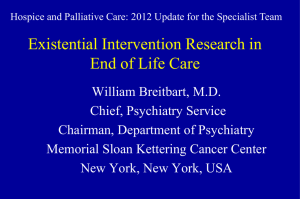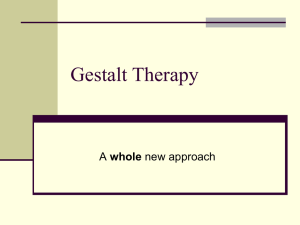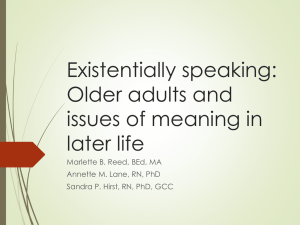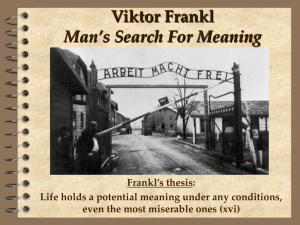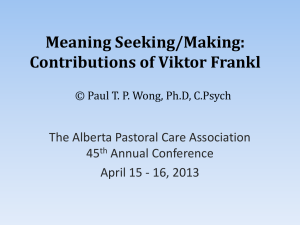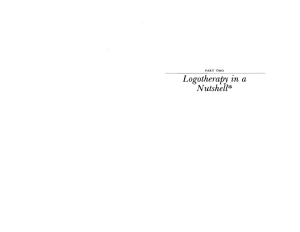here
advertisement
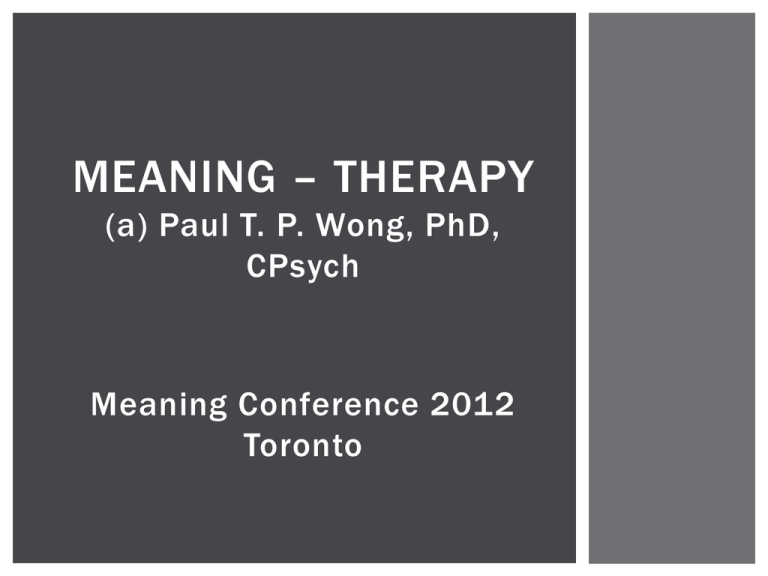
MEANING – THERAPY (a) Paul T. P. Wong, PhD, CPsych Meaning Conference 2012 Toronto LEARNING OBJECTIVES Learning an integrative and innovative way to repair the worst and bring out the best. Learn how to develop the meaning-mindset as the basis for personal transformation Learn how to use the strategy of double vision in achieve optimal effective coping. Learn how to use the PURE strategy to build a meaningful and rewarding future. Learn the apply the basic ABCDE intervention strategy to a variety of problems. Why we need an integrative approach THE MEANING MINDSET Meaning Fulfillment Sacrificial Life Ideal Life Failure Success Wasted Life Shallow Life Emptiness LIFE ORIENTATION SCALE 1. I can find something meaningful or significant in ever yday events. 2. There is a reason for ever ything that happens to me. 3. There is no ultimate meaning and purpose in life. 4. There is no point in searching for meaning in life . 5. No matter how painful the situation, life is still wor th living . 6. The meaning of life is to “eat, drink and be happy .” 7. What really matters to me is to pur sue a higher purpose or calling regardless of per sonal cost . 8. I would rather be a happy pig than a sad saint. 9. I am willing to sacrifice per sonal interests for the greater good . 10. Personal happiness and success are more impor tant to me than achieving inner goodness and moral excellence . CHOOSING THE ROAD LESS TRAVELLED MEASUREMENTS OF MEANING & PURPOSE IN LIFE Life Orientation Scale (LOS; Wong, 2012) Personal Meaning Profile-Brief (PMP-B; Wong, 2012) The PURE Test (Wong, 2011) Meaningful Living Scale (MLS; Wong, 2011) Coping Schema Inventory – Revised (CSI-R; Wong, Reker, & Peacock, 2006) THE MOTTO OF MT Meaning is all we have. Relationship is all we need. Effective therapy depends on making full use of our capacity for meaning making and relating. WHAT IS MEANING-THERAPY (MT) It evolves from logotherapy and cognitive behavioral therapy. It is part of the third wave of psychotherapy which involves powerful new concepts such as acceptance, commitment, self-transcendence, and meaningmaking. Viktor Frankl is the father of logotherapy. WHO IS VIKTOR FRANKL? 1905-1997 WHAT IS LOGOTHERAPY? Logotherapy literally means therapy through meaning. It is a spiritually-oriented approach towards psychotherapy. Existential analysis is needed to make the clients aware of their spirituality and capacity for meaning . “Inasmuch as logotherapy makes him aware of the hidden logos of his existence, it is an analytical process” (Frankl, 1984, p. 125). THE BASIC TENETS OF LOGOTHERAPY Freedom of will: Not only freedom from some negative condition but also freedom to something rewarding. Will to meaning: Striving to find a meaning in one’s life is the primary motivational force. Meaning of life: One can always discover meaning in life regardless of life’s circumstances. THREE BASIC PATHWAYS TO MEANING Creative value: giving something to the world through creative works. Experiential value: receiving something from the world through appreciation and gratitude. Attitudinal value: taking a heroic stand towards suffering and fate. EXISTENTIAL VACUUM Many people seek healing of inner emptiness because of a felt sense of existential vacuum. Frankl believes that existential vacuum may lead to both the tragic triad and neurotic triad. Meaning therapy is uniquely suitable to address these mental health issues. THE TRAGIC TRIAD pain guilt death THE NEUROTIC TRIAD depression aggression addiction EXISTENTIAL ANXIETIES According to Irwin Yalom (1980), there are at least 4 universal existential anxieties: 1. 2. 3. 4. Loneliness or alienation Freedom of choice (basic ontological crisis) Death anxiety Meaninglessness (related to the above three) Many psychiatric symptoms such as depression and anxiety are manifestations of the underlying existential anxieties. THE DEFINING CHARACTERISTICS OF MT Integrative/holistic Existential/spiritual Relational Positively oriented Multicultural Narrative Psycho-educational LAYING THE GROUNDWORK FOR POSITIVE CHANGE Carl Rogers’ 3 pre-conditions for effective counselling. 1. Empathy 2. Unconditional positive regard (nonjudgmental) 3. Congruence or genuineness [ THE THERAPEUTIC PRESENCE Who we are is more important than what we say. Rogers’ three pre-conditions need to be the personal characteristics of counsellors. Personal wholeness of the therapist is important. The messenger is the message. The therapist is the therapy. The counsellor brings a healing presence. The counsellor models meaningful living. The counsellor practices counselling by osmosis. HEALING THROUGH RELATIONSHIP Building rapport and trust is essential to effective therapy. Authentic and caring relationships has more healing power than therapeutic alliance. Accepting resistance and negative reaction as part of the healing process. The ground rule of respect and caring applied to both the therapist and the client. Recognize that each individual is both unique and similar. DIFFERENT LEVELS OF RELATING At the social level, two strangers get to know each other in a trusting and non-judgmental environment. At the existential level, two human beings share their common humanity. At the professional level, the therapist is responsible for achieving desirable therapeutic goals. Therapy involves the reciprocal influence between the therapist and the client. LEVELS OF LISTENING 1.Listening 2.Listening 3.Listening 4.Listening 5.Listening 6.Listening 7.Listening with one’s ears with one’s eyes to one’s cultural voice with one’s head with one’s heart with one’s soul to the spirit BARRIERS TO CLEAR COMMUNICATION Confusing fact with fiction Confusing emotion with intention Confusing past with present Biases and assumptions Lack of empathy and sympathy Lack of attention and focus Delayed emotional explosion Making dispositional attributions Different styles of communication Different levels of listening THERAPEUTIC GOALS To awaken the client’s awareness of personal responsibility and meaning in life. To achieve a deeper understanding of the problem from a larger perspective. To help the client discover their true identify and place in the world. To help the client pursue what really matters in life. THERAPEUTIC GOALS CONT’D To grow and develop the client’s full potential. To make life better for self and others. To transform a victim’s journey into a hero’s adventure. To discover meaning and hope in boundary situations. To learn principles and skills to achieve positive outcomes and transform negative outcomes through meaning. THERAPEUTIC PLAN Cultivating a healing presence. Creating a safe and trusting environment. Explaining to clients the MT approach. Listening proactively to discover the nature of presenting problems and unspoken needs. Agreeing on the priority of issues to be addressed. Developing a concrete plan for actions. Emphasizing the demand for responsibility and restoration of meaning and purpose. THE ART OF QUESTIONING Responsibility questions Choice questions Trajectory questions Quest questions Eight enduring existential questions Magic questions Diagnostic questions EIGHT ENDURING EXISTENTIAL QUESTIONS 1. 2. 3. 4. 5. 6. 7. 8. Who am I? How and where do I find happiness? What should I do with my life? How can I avoid making the wrong choices in the major areas of my life? Where do I belong? What is the point of all my striving? What will happen to me after I die? What would make my life more meaningful and significant? MEANING-CENTERED INTERVENTIONS Part 1: The Double Vision Strategy and the PURE Principles DOUBLE VISION Try to identify the underlying existential anxiety for each presenting problem. Solution-focused therapy needs to consider both the immediate problem and the larger personal issue. Short-term goals need to be related to larger life goals. Do not focus on the leaves and ignore the forest. Keep one eye on the ball and another eye on the goal. MICRO VS. MACRO SKILLS Micro-skills refer to interventions that target specific situational problems. Attribution retraining Cognitive reframing Macro-skills refer to interventions that target larger societal, ecological, cultural, and existential problems Advocating for social change and community reform. Identifying the macro-forces that contribute to one’s problems. THE PURE PRINCIPLES The four treasures of MT: Purpose – the motivational component Understanding – the cognitive component Responsible action – the behavioral component Evaluation – the affective component PURPOSE Including goals, directions, incentive objects, core values, aspirations and intentions. What do I want to get from this situation? What should I do with my life? What really matters in life? Deciding on one’s ultimate concern: The happiness mindset vs. the meaning-mindset (Wong, 2011). Beware of the pitfalls of the pursuit of happiness. UNDERSTANDING Encompassing self-understanding, a sense of coherence, making sense of situations and other people. Having a clear sense of who one is, what one is and what one’s place in the world is. Don’t be a stranger to oneself – dare to open the dark rooms and secret chambers in one’s life. Knowing another person’s true intention and feelings thru effective communication Having the practical wisdom to make sound judgments and good decisions. RESPONSIBILIT Y Freedom and responsibility go hand in hand. Doing the right thing and finding the right solution. Choosing appropriate reactions and actions in situations of conflicting values and demands. Holding oneself accountable for one’s own behavior. Discovering to what extent one is responsible for a given problem. Blaming only makes things worse. Take ownership of one’s life and assume full responsibility for building a preferred future. ENJOYMENT/EVALUATION Assessing degree of satisfaction with the situation or life as a whole Living a life of purpose, understanding and responsibility does not always guarantee happiness. Have I achieved what I set out to do? Am I happy with how I have lived my life? If this is love, why am I still unhappy? Self-regulation depends on self-reflection and evaluation. SOURCES OF MEANING According to Wong (1998), there are 8 sources of meaning and the good life. 1. Achievement 2. Acceptance 3. Transcendence 4. Intimacy 5. Relationship 6. Religion 7. Fairness 8. Positive emotions A MEANINGFUL LIFE IS A BALANCED ONE Religion/ Spirituality Achievement Acceptance Intimacy Relationship Self-transcendence Fairness Situational and Cultural Context Healing and Flourishing DEFINITION OF A MEANINGFUL MOMENT 1. It is deeply felt – It touches your emotions in a deep and lasting way. More than a fleeting feeling, it reaches your inner most being. 2. It is deeply processed – It involves deeper layers of meaning beyond the factual and superficial. 3. It is enlightening – It provides a solution to some puzzling problems or leads to some new discovery. 4. It is transforming – It enriches your life, changes your life’s direction or restores a sense of purpose and passion to your life. Meaning-mindset (Overall Orientation) Meaningful moments (Experiences) PURE Framework (Structure) Sources of meaning (Content) Frankl’s 3 basic tenets and values of meaning (Foundation) MEANING-CENTERED INTERVENTIONS Par t 2: ABCDE Model of Resilience Tragic Optimism The DualSystems Model WHEN TRAGEDY STRIKES The best built house can be destroyed. No one is immune from suffering and tragedies. Bad things do happen to good people. There is a breaking point for everyone. The challenge is to recover and become stronger. FOUR LIFE TRAJECTORIES PATTERNS OF RESILIENCE Recovery: Bouncing back and returning to normal functioning. Invulnerability: Remaining relatively unscathed by the adversity or trauma. Post-traumatic Growth: Bouncing back and becoming stronger. ABCDE STRATEGY Accept and confront the reality -- the reality principle. Believe that life is worth living – the faith principle. Commit to goals and actions – the action principle. Discover the meaning and significance of self and situations – the Aha! principle. Evaluate the above – the self-regulation principle. ACCEPTANCE Accepting what cannot be changed. Accepting reality, limitations, loss, trauma, existential givens. Acceptance does not mean giving up or resignation. Confronting one’s worse fears with courage and tragic optimism. Transcending and transforming the tragedy. THE COURAGE OF SELF -ACCEPTANCE LEVELS OF ACCEPTANCE Cognitive acceptance Emotional acceptance Realistic acceptance Integrative acceptance Existential acceptance Transcendental acceptance Transformative acceptance BELIEF Affirming one’s ideals and core values. Recognizing the intrinsic value and meaning of life. Receiving support and help from others. Turning to a personal God or higher power. Growing and striving for positive transformation. Believing in an eventual triumph of good over evil. Recognizing the worthwhileness and authenticity of one’s mission. Recognizing and using one’s competencies, character strengths and virtues. COMMITMENT Moving forward and carrying out one’s responsibility with determination. Doing what needs to be done regardless of feelings or circumstances. Striving to fulfill one’s responsibility no matter what. Enduring hardship and pain for your cause. Problem-solving and effective coping. Avoiding errors and temptations. Practicing the PURE principle. Pursuing realistic goals. Re-authoring one’s life story. DISCOVERY Learning something new about the self and life. Digging deeper, exploring farther, and searching higher. Discovering one’s hidden courage and strength. Discovering the power of faith and spiritual resources. Grasping the complexities of life and people. EVALUATION Savoring small successes or re-assessing one’s progress. Feeling relief that the worse is over. Monitoring progress. Savoring the moments of small success. Reflecting and reviewing one’s life. Receiving feedback from others. Conducting assessments and making adjustments. ELEMENTS OF TRAGIC OPTIMISM Acceptance of the worst. Affirmation in the value and meaning of life. Self-transcendence (altruism). Faith in God and others. Courage to face adversity. DUAL-SYSTEMS MODEL We can best achieve adaptive success through integrating approach and avoidance systems. The approach system – life expansion The avoidance system – life protection Employ offence and defence at the same time. A Dual-Systems Model Individual differences and personal resources Positive Conditions Negative Conditions PURE Approach Avoidance ABCDE Cultural and Contextual Variables Positive Outcome Negative Outcome INTERACTIONS BETWEEN THE TWO SYSTEMS We instinctively approach what is perceived as appetitive, and avoid what is perceived as aversive or noxious. The approach and avoidance systems involve different emotional-behavioral processes and neurophysiological substrates. INTERACTIONS BETWEEN THE TWO SYSTEMS (CONT’D) The positive system seeks to do what is desirable and preferable. The aversive system serves as a warning about what is wrong in one’s life and what is potentially threatening. There is a downside to positives and upside to negatives. INTERACTIONS BETWEEN THE TWO SYSTEMS (CONT’D) Together, these two self-regulation systems provide a road map to make life worth living through good and bad times. Meaning management helps integrate both negative and positive systems. POSITIVE TRIAD OF HEALING AND FLOURISHING ABCDE Tragic Optimism Approach Avoidance PURE MEANING-BASED MODEL OF WELL-BEING AND MENTAL HEALTH Complete Mental Health and Flourishing Reduced Negativity & Increased Resourcefulness Personal Growth, Character Strengths, & the PURE Model (Factor II) Broaden-and-Build Model of Positive Emotions Experience of Positive Emotions (Factor I) Deep-and-Wide Theory of Effective Coping (Factor III) Sources of Meaning
